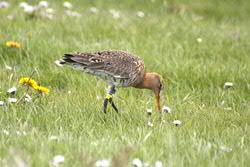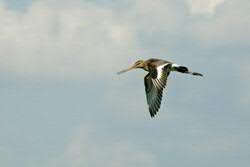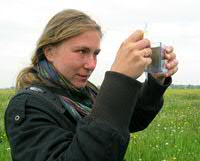Mow even later to save the godwit
Meadows where godwits breed should only be mown after 1 July. This would be the most effective measure to call a halt to the continual decline in godwit numbers. This has been revealed by research conducted by Rosemarie Kentie, who will be awarded a PhD on 9 January 2015 by the University of Groningen.

Most grants for meadow bird protection are based on a mowing date of 15 June or even earlier. This is still much too soon for most of the godwit chicks, states Kentie. ‘In addition, the positive effects of mowing later would mostly be cancelled out if future protection concentrates only on a few selected key areas where there are currently a lot of godwits. Too many young godwits would “stray” to areas without protection, where they in turn would be able to raise far too few chicks.’
Coloured rings
In the past ten years, Kentie and her colleagues have been conducting field research on the godwits in southwest Friesland (in the North of the Nethetlands). They fitted thousands of birds with coloured rings, to make them individually recognizable at a distance. This enabled them to follow the dispersal of the birds over the breeding areas, their survival, breeding success and their migration over several years.
Herb-rich meadows versus monoculture

In her thesis, Kentie compared the godwits that breed on intensively farmed grasslands with birds that breed in damp, herb-rich meadows, where special ‘meadow bird management’ is usually also in place. In the years of the research, between 20 and 60% of the eggs laid on intensively farmed grasslands hatched. In herb-rich meadows this was between 50 and 70%.
Kentie: ‘The percentages on the herb-rich meadows are comparable with the hatching percentages in the early 1980s, when there were no foxes and also fewer other predators in the meadows. It’s thus not logical to blame only foxes for the decline in meadow birds. These predators seem to mainly profit from intensively farmed meadows, where it’s easier for them to find the nests in the shorter grass.’
Alongside the lower percentage of hatched eggs, the chances of chicks from intensively farmed grasslands growing into breeding birds were also significantly lower. ‘We have shown that these chicks grow less successfully, so lack of food will play a role here’, according to Kentie.
From source to black hole
In most of the years of the research, the herb-rich meadows were a ‘source’ of godwits – more chicks grew up than breeding birds died. Despite this, the population there did not increase. This is because young birds in particular spread across the country in subsequent years, often moving from the good, herb-rich meadows to monoculture areas. In these monoculture areas, reproduction was too low to compensate for the deaths – grassland monoculture areas were thus a notorious ‘black hole’ into which godwits from successful areas also disappeared without trace.
In her thesis, Kentie states that it may not be enough to concentrate efforts to protect meadow birds solely on the successful meadow bird areas. ‘Young godwits, and even a few of the adults, will move from the good areas to poorer areas in subsequent years. If you really want to halt the decline, you will somehow have to actively encourage the birds in the intensively managed farmland to move to the herb-rich meadows. Or there will have to be so many chicks growing up in the meadow bird areas that it won’t matter any more that some leave.’
Predictions
Over 80% of all West European godwits breed in the Netherlands. Despite continual attempts to protect the meadow birds, the number of godwits has declined in the last forty years from 120,000 breeding pairs to about 35,000 breeding pairs, writes Kentie. The PhD student used computer calculations based on all possible characteristics of the birds as well as the influences of the environment to create a ‘godwit prediction’. If nothing changes in the way we manage the meadows, the godwit population will be decimated in the next century.
If the first mowing date in meadows specially managed for godwits is postponed from 15 June to 1 July, Kentie’s computer model expects a potential increase in the number of godwits over the next century. ‘However, these meadows must also be fertilized less. Otherwise the grass will grow too long and too thick, which means the chicks will no longer be able to walk through it in search of insects.’
CV

Rosemarie Kentie (Amsterdam, 1981) did her PhD research at the Center for Ecological and Evolutionary Studies of the University of Groningen. The title of her thesis is Spatial demography of black-tailed godwits - Metapopulation dynamics in a fragmented agricultural landscape. Her promotores are Theunis Piersma and Christiaan Both.
| Last modified: | 17 September 2021 11.46 a.m. |
More news
-
01 April 2025
NSC’s electoral reform plan may have unwanted consequences
The new voting system, proposed by minister Uitermark, could jeopardize the fundamental principle of proportional representation, says Davide Grossi, Professor of Collective Decision Making and Computation at the University of Groningen
-
01 April 2025
‘AiNed’ National Growth Fund grant for speeding adoption of AI at SMEs
Professor Ming Cao receives an ‘AiNed’ Growth Fund grant of EUR 2.4 million for research that will contribute to faster adoption of AI at SMEs in the technical industry in the Netherlands.
-
01 April 2025
'Diversity leads to better science'
In addition to her biological research on ageing, Hannah Dugdale also studies disparities relating to diversity in science. Thanks to the latter, she is one of the two 2024 laureates of the Athena Award, an NWO prize for successful and inspiring...
